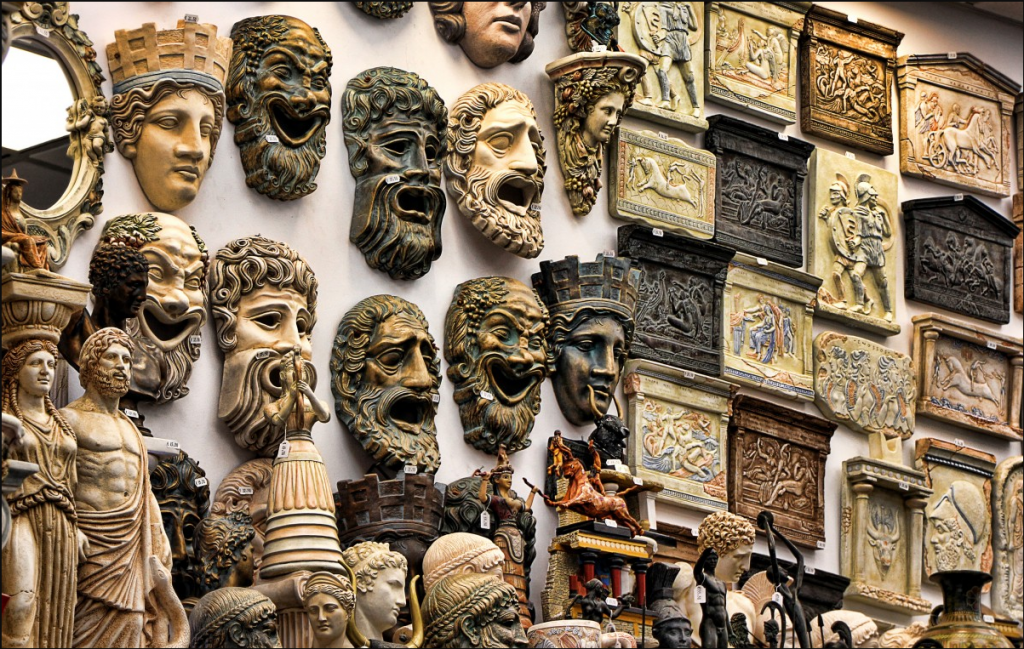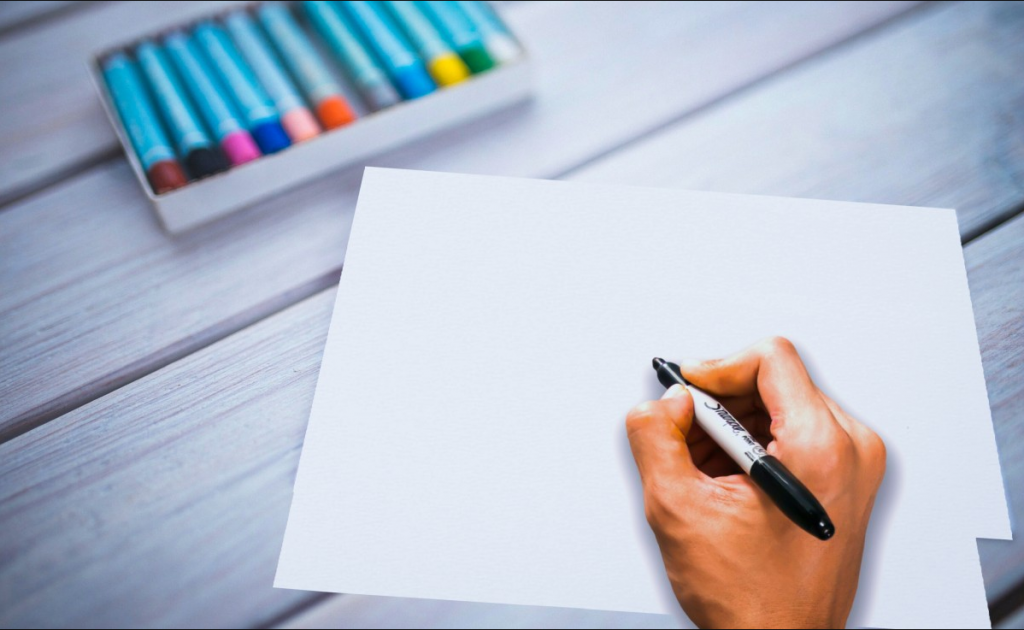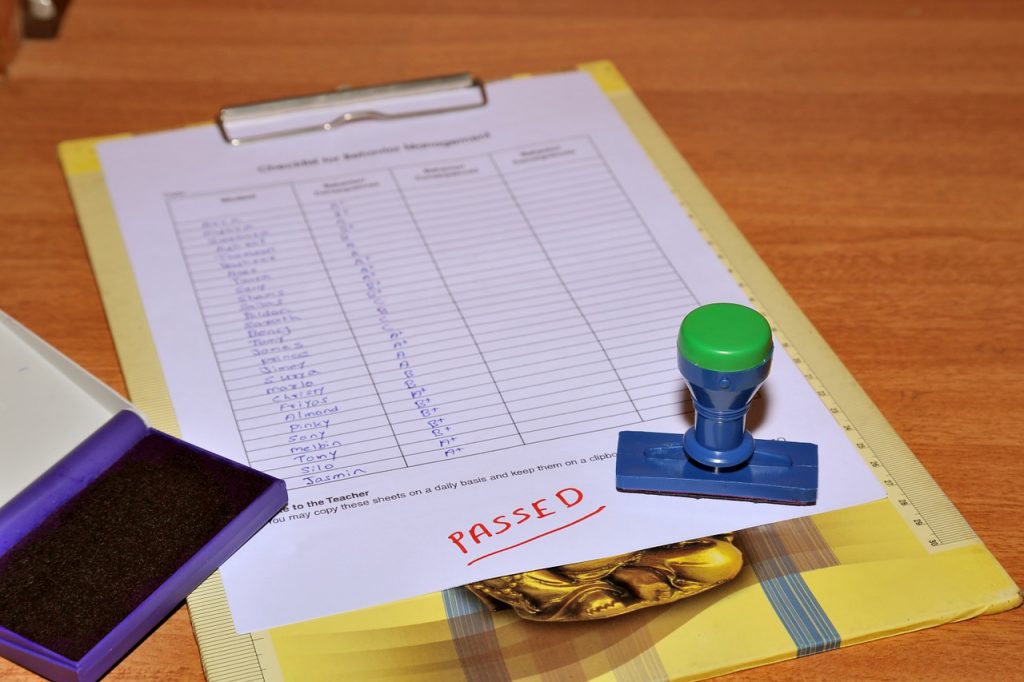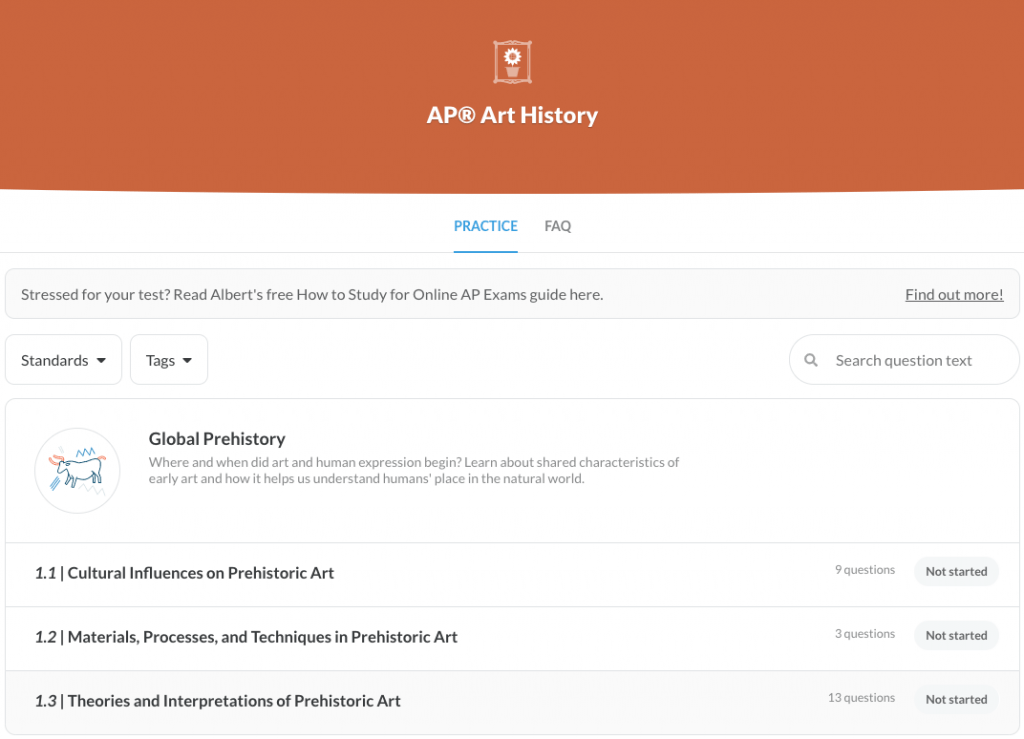Everything I Need to Know to Pass My Ap Art History Exam on the Idigneous Americas and Africa
This AP® Fine art History study guide provides you with the tools you need to succeed on the exam—and to become the score you want!
What's on the AP® Art History Examination?
AP® Fine art History is the equivalent of a two-semester college-level art history survey course, roofing art from the Paleolithic era through today. Co-ordinate to the CollegeBoard, Advanced Placement Art History explores the nature, uses and meaning of art, its creation and audience responses. The class encourages students to sympathize art from a global perspective, with insights into its history and development.
There are 3 distinct ways to clarify art, all of which are used in the form, and tested on the AP® Fine art History test–and y'all should know them for your AP® Fine art History study program.
1. Visual Analysis. A visual analysis asks you to expect carefully at a work of fine art and report what you run into near the work of art. The visual analysis looks but at what is present in the work, non at what led upward to the work of art. Offset, you lot should wait at the formal elements of the work, including line, colour, shape, class and naturalism. Adjacent, you should consider composition, the way individual visual elements are put together. The elements of composition are symmetry, residual, proportion and scale, and rhythm. These various factors combine to create the totality of the limerick.
two. Contextual Analysis. A contextual analysis looks at how the work of art fits into and impacts the globe around information technology. Contextual analysis requires you consider other works of fine art of the fourth dimension, historical events, the place of cosmos, and the patron of the piece of work.
three. Comparative Analysis. A comparative analysis compares and contrasts two or more works of art, incorporating both visual and contextual analysis of each work. The 2 works may be from the aforementioned period or from different periods, and may even be different media; nonetheless, in most cases, there will be some similarity, whether in subject, mode, patronage, or function.

Large Ideas, Essential Questions, and Learning Objectives.
The course is organized around three Big Ideas. You should proceed these ideas in heed equally you fix for the test. This is i of the most important art history tips. Each of the Big Ideas is closely connected to an Essential Question, and to several Learning Objectives. Essential Questions in art history will assistance to guide your work in the grade and your preparations for the big exam day. Learning objectives help you to understand what the CollegeBoard thinks that you should have from your studies in this course—we've paraphrased those below for you lot!
Big Idea #ane
Artists manipulate materials and ideas to create an aesthetic object, act or issue. The Essential Question for Big Idea #one is: What is art and how is it made? There are four Learning Objectives related to this Big Idea.
- Differentiate form, role, content and/or the context of a work of art.
- Explain how artistic decisions about art making bear on fine art.
- Describe how artistic and historical context influences artistic decisions involved in creating a work of art.
- Clarify the form, function, content and/or context to explain or decide the artist'due south intentions during the cosmos of the work.
Large Idea #2
Art making is shaped by tradition and change. The associated Essential Question is: Why and how does art modify? The three Learning Objectives fastened to Big Idea #ii are:
- Depict features of an artistic tradition and/or change in a single piece of work of art or a grouping of related works.
- Explicate how and why specific traditions and/or changes are demonstrated in one or more works of art.
- Analyze the influence of a single work of fine art or group of related works on works of fine art produced around the aforementioned fourth dimension or later.
Large Idea #3
Interpretations of art are variable. The Essential Question for Big Idea #iii is: How practise we describe our thinking about art? The Learning Objectives are:
- Identify a work of art with cardinal identifiers, including artist or culture, date, and cloth.
- Clarify how formal qualities of the piece of work and/or content of a work of fine art brings about a response from the viewer.
- Consider how contextual factors lead to different interpretations of art.
- Justify attribution of an unknown piece of work of fine art, using formal qualities and comparisons to other works.
- Analyze relationships between different works of art based on their similarities and differences.

Content Areas, Enduring Understanding Statements, and Essential Knowledge Statements
AP® Art History is divided into ten singled-out content areas. Each content surface area is represented past a number of works in the collection of 250 works used in the course. These images are the works yous are expected to acquire and think for the examination. Individual works may include multiple views or images, but count as a unmarried entry in the Image Set. Understanding these content areas is essential for test training. Each content area has a set number of works in the Paradigm Gear up and typically, represents a rough per centum of the test questions. Knowing these content areas is essential for your art history study plan.
- Global Prehistory from 30,000 to 500 BCE (xi works, four%)
- Ancient Mediterranean from 3,500 BCE to 300 CE (36 works, 15%)
- Early on Europe and Colonial America from 200 CE to 1750 CE (51 works, 20%)
- Afterward Europe and the Americas from 1750 to 1980 CE (54 works, 22%)
- Ethnic Americas from 1000 BCE to 1980 CE (14 works, 6%)
- Africa from 1100 to 1980 CE (14 works, 6%)
- Westward and Central Asia from 500 BCE to 1980 CE (11 works, 4%)
- South, East and Southeast Asia from 300 BCE to 1980 CE (21 works, viii%)
- The Pacific from 700 to 1980 CE (11 works, 4%)
- Global Contemporary from 1980 to present (27 works, 11%)
What tin you notice about the content areas? The first four are chronological. In these four content areas, yous'll come across an evolution of art that y'all may recognize. In these content areas, you can see interactions between diverse cultures, as they traded with i another, and learned from one another. These offset four content areas cover the time period from xxx,000 BCE to 1980, or from the primeval works of fine art created by humans to relatively contemporary art. They are somewhat limited geographically. These 4 content areas include works common to the evolution of western art.
The adjacent 5 content areas are specific to various regions, ranging from the Indigenous Americas through the Pacific. In many cases, fine art in these regions developed somewhat independently, with only occasional influences from other cultures. In these content areas, a long period of time is covered in a narrow geographic area.
The 10th content surface area covers a very short fourth dimension flow, simply art from around the earth. This speaks to a pregnant change in the world in recent years—access to travel and data mean that geography is less of a consideration in the gimmicky art world. Artists may motility effectually the world, and take access to works by other artists from distant locations.
The various content areas are accompanied past Enduring Understanding statements associated with each content area, too as connected Essential Knowledge. Enduring Understanding statements provide a short overview of the content area, while Essential Knowledge provides a brief introduction to key components or factors that influence the content expanse. Think of Indelible Understanding and Essential Noesis as the most bones things y'all should know nearly each of the content areas; while you should know a lot more that, these provide you lot with the foundations of understanding for each area.
- If yous acquire the Indelible Agreement statements and the Essential Knowledge statements for each of the content areas, you'll accept a good understanding of the basics you lot need to know for the diverse periods and regions.
- Essential Knowledge statements commonly include data about creative movements, too as relevant cultural and historical events during the menses or in the region.
The Exam Format
The AP® Art History examination is a three-hour examination. Rules, procedures and scoring are the aforementioned every bit other AP® examinations and are available from your teacher or the CollegeBoard website. Exam proctors will announce the passage of fourth dimension; however, you may motion through the individual sections of the test at your own pace.
One hour is spent on multiple choice questions almost the works of fine art you've studied. There are lxxx multiple choice questions. Thirty-five of those are individual questions, and the remaining 45 questions are in sets of multiple questions about the same piece of work or works of art. You have merely one hour for these fourscore questions, and so it's important to be able to move chop-chop through the questions. In that location are no penalties for incorrect answers, so be sure to respond every multiple-choice question.
Two hours are spent on free-response, or essay-style, questions. There are six questions in total, made upwards of four short essays (15 minutes each) and two longer essays (thirty minutes each).
Both multiple-selection and free-response questions are designed to assess pupil understanding of all class learning objectives. In wide terms, multiple choice questions are more probable to assess your ability to identify works of art and place them in context correctly; nonetheless, you may also be asked questions almost works that are similar to those you have studied, or questions that crave you place a work in its historical context.
All free-response questions on the AP® Fine art History exam are associated with an image or multiple images. While free-response questions are designed to show deeper understanding of the material included in the class, students are also expected to correctly identify the works of art. Identifiers include the title of the work, the name of the artist or culture that produced the piece of work, the engagement of creation and the materials used in the work. At least two of these identifiers must be present and correct for full credit; however, students will non exist penalized if additional identifiers are incorrect.
When you write the 4 short essays, they should be focused solely on the works included in the free-response question. For the 2 longer essays, yous may bring in relevant works not included in the form, where appropriate.
Scoring
While the scoring of multiple pick questions is straightforward, you do need to empathise how the CollegeBoard scores, or grades, AP® exams, including the AP® Art History examination. Complimentary-response questions are graded past a large team of higher faculty and experienced Advanced Placement teachers. Scores on free-response questions are weighted and advisedly assessed.
The raw score, created by combining gratis-response scores produced by human readers and the computer-generated multiple choice score are converted into a single number score between 1 and 5. Individual colleges and universities may set their own standard for accepting AP® scores; however, you tin can reasonably think of a five every bit an A, a four as a B and and so on. Well-nigh schools exercise not accept whatsoever score below a iii for total college credit. Yous can think of a 3 as somewhere betwixt a B- and a C. The American Council of Didactics recommends credit be granted for scores between three and v. A score of i or two volition typically result in no college credit for the class.
Officially, the scores are defined as follows:
- 5 = Very well qualified
- 4 = Well qualified
- 3 = Qualified
- 2 = Possibly qualified
- i = No recommendation
Your goal, assuming y'all're in this for the higher credit, should be a 4 or five, to be on the safe side.
Preparation for the AP® Art History Exam
Preparing for an art history test can be a little different than preparing for any other kind of test. You don't only have to retrieve facts, but images! For some people, this is really easy, but for others? It tin be a piffling harder. A smart art history study plan tin can help.
Permit'southward start by talking nigh the identification part of art history. For many people, this is the time they need fine art history tips! Remember, you demand to be able to identify the title, artist or culture, appointment of creation, and the materials used in the work. It'due south not simply about memorizing those things—you take to connect all of that data to the paradigm or images of the work. For some works, in that location may exist more than than one paradigm. For instance, the Parthenon in Athens may have more than one view of the edifice, also every bit a floor plan. You need to exist able to match all of that data to whatsoever of those images.
Unfortunately, in that location'southward a sad reality here. All of that data? You need to memorize it, along with the associated image or images, hence the demand for an fine art history written report plan. In that location are a few unlike strategies for that, depending upon your own preferences and what works best for you. Try these fine art history tips to memorize what you lot need to know.
- The sometime fashioned solution is an index card. Print and gum images to the front and write identifying data on the back. This option works well if writing helps you to remember information, or if you like low-tech solutions.
- Go online. There are a number of web sources that offering images plus identifying information to help you study for the test. In add-on, a visit to the iTunes App Store or Google Play volition provide you with options for apps that do the aforementioned. These solutions work well if you study effectively using online or digital tools, and tin can make it easy to study on-the-go if you lot always accept a telephone available.
- Combine these strategies. Maybe you lot'll make the index cards (yeah, all 250 of them), merely likewise use an app for review when you're on the bus or have fourth dimension between classes. If you're non certain how you'll study all-time, this may be your best program.
Regardless of which of these you cull, you'll need to put in the hours—and a lot of them—for a good score on the test. Arrive the habit of reviewing daily for thirty minutes to an 60 minutes for a proficient score in the weeks before the exam. Memorizing the images and info is only the offset office of preparing for the big examination day. You lot as well have to be able to place all of this art history information in context. What else was happening when the work was made? Why did the artist make the work? How does it relate to art created earlier information technology or later on it? All of those questions and others, apply to each work you written report in Advanced Placement Art History.
How can you learn the context and commit it to memory? Merely like with identifying art works, the context needs to be linked in your retention to the associated images. There are a number of things you lot can exercise to help amend understand (and remember!) the context of works of art.
- Make a timeline. Y'all tin can do this online, or by hand on paper; you may want to make one for each of the content areas.
- Create outlines of each content expanse, incorporating essential historical events, artistic movements and works of art.
Think nigh how you learn all-time. Different people learn by hearing, reading, doing, or some combination. If you learn by reading, focus on that; all the same, if you learn all-time by hearing, you may find that podcasts and documentaries provide a amend source for review of dissimilar periods, artists and works of fine art. Be sure that you choose reliable and high-quality source material. It'southward fine to go exterior of your textbook, but it's critical that yous opt for fabric with scholarly backing.
- Become a study buddy or form a report group with classmates. Spread the content groups around your study companions and each produce and teach the information to review it finer. This is a smart choice for an art history study program.

Writing the Costless-response Answers
Multiple-choice questions are cocky-explanatory, even if working with grouped questions is new. You've been answering these kinds of questions since kindergarten. The complimentary-response questions on the AP® Art History examination aren't quite and so unproblematic; the CollegeBoard expects carefully idea out and well-written responses to their questions. Information technology's non a matter of simply writing a few lines, like you might have for short answer questions or a paragraph or two, like you may be used to from essay questions in other classes.
As noted, you'll have to write four shorter, 15-minute gratuitous-response answers and ii longer gratis-response essays. The long essays, called Part A, come before the short essays, or Part B. You lot may move from ane essay to the other in Part A when y'all're set up, merely cannot move onto Role B until time is called.
Let'southward commencement with the nuts, for each of these questions. Before you start writing, you should accept only a few minutes to produce a cursory outline. This lets you programme what y'all're going to write and enables y'all to make sure yous're effectively answering all parts of the question. Don't forget, you take to identify all works used in the free-response questions with at least ii correct identifiers.
This isn't a formal outline, and no one'south going to grade you on information technology. You only need to write as much as you need to follow information technology and plan out your essay response. It may just be the identifiers, plus a few keywords, or it may be slightly more involved. You lot shouldn't spend more than five minutes on your outline for the longer free-response question, and ii or three minutes for the shorter response questions. Taking up fourth dimension with planning may seem counter-intuitive, simply it can mean the difference between a good essay and a cracking 1.
Now, why are nosotros talking about this during the test preparation stage? Well, because yous don't just accept to report. You also accept to prepare to write the free-response answers on examination day. Practicing your essay answers volition aid you to exist ready to take the examination. The CollegeBoard offers by year questions, enabling you to get an idea of what to await on the AP® Art History exam. These are the best choice for practice questions!
There is 1 problem—y'all don't have anyone to grade your free-response practices! Think about sharing these in your report grouping, with a friend, with a parent, or seeing if your teacher, or even another instructor in your school, volition provide feedback on at least some of your practice essays.
Resources
- AP® Art History Course and Examination
- Albert.io's Art HistoryBlog Articles
- Albert.io'due south Art History Questions
- Khan Academy'south Slideshow of AP® Art History Images
- John Costello'south AP® Fine art History Videos
Practice Tests
After y'all study, information technology's important that you take do tests. The key give-and-take in that sentence is tests—in the plural! Expect to have several tests, adjust your report strategy and repeat the process. Now, we're going to tell you lot what you don't want to hear. For the about effective preparation, you should have these tests in weather condition that replicate examination solar day as much as you're able. A repose desk-bound, limited distractions and a timer are key. Turn your phone on do non disturb, or plow information technology off, skip the music, and get to testing. This is the best style to place your strengths and weaknesses; however, yous should proceed in mind that you lot don't have the benefit of professionally scored essays. As with your practice essays, ask a friend, family member or teacher to read your free-response answers and provide feedback.
Analyzing Results
Once you've taken the examination, yous need to honestly analyze your results.
- Interruption the multiple choice questions downwards into their content areas. Can you lot see articulate areas of force or weakness? Perchance yous realize that you're great with the ancient world simply awful at gimmicky. Adjust your written report time to help accommodate these weaknesses.
- If you realize that you've made consistent errors across unlike content areas in ane identifier or another, specifically review that identifier. For many people, dates are one of the virtually hard parts of art history, but they're nonetheless an of import identifier.
- Are yous having trouble with i of the Big Ideas or Essential Questions? Practice y'all need to work on your agreement of one of these central guiding factors in AP® Art History?
- Read through your gratuitous-response answers. Can you lot encounter whatsoever articulate problems? Did you remember to identify all artworks, and to programme out your essay? Were you lot able to consummate your essay in the allotted time? What kind of feedback have you received most your answers from friends or teachers?

Adjusting Your Strategies for the Best Score
In one case you've taken a practice test, beingness sure to recreate test weather equally much every bit possible, yous'll likely need to suit your study strategies to accommodate your own strengths and weaknesses.
Write down your strengths and weaknesses. Why do you think you're stronger in some things and weaker in others? What can you lot do to tap into your strengths and brand your weaker areas better?
Content Areas
When you analyzed your scores, you looked at where yous were weak, or what was hardest for yous. Mayhap you're stronger when you know more about the history or civilization—if so, endeavor reading a book or watching some documentaries to assistance provide more information nearly the history and culture. Perhaps y'all just need more exposure to less familiar works, and should focus some extra energy on reviewing those works. Be sure yous continue to review material you lot know well, but information technology'south fine to focus much of your report time on your weaker areas.
Identifiers
Are you struggling with one type of identifier? If so, remember of different means to organize material, both during your study time and in your brain. For instance, you may need to link works made in Europe in the 14th century to ones fabricated in China in the 14th century to recognize that these very dissimilar works have the same dates, or use mnemonics or other memory tricks to aid y'all call back the names of artists or cultures. If you struggle with materials, take a trip to a local museum to become a better, in-person look at the difference between marble and limestone or watercolor and oil paints. If y'all're struggling with all identifiers, consider changing up your study strategy; if you lot've used flashcards, try an app or online quiz or try handmade flashcards if yous're using an app.
Free-response Questions
If you've done quite well on the multiple selection but take concerns about the gratuitous-response questions, in that location are several ways to suit your study strategies. Start, read examples of good essay responses—even those not written for AP® Art History! Take the fourth dimension to recollect virtually what was good about the essay and to model your own answers after high-quality responses. Recollect, fifty-fifty a free-response answer should include a brief introduction and determination, equally well as a clear thesis argument! Next, practice writing to a timer. Even for proficient writers, getting that gratis-response completed in fifteen to 30 minutes in a challenge!
Gratis-response questions may ask you to do one or more than types of analysis. Remember, art history uses visual analysis, comparative analysis and contextual analysis. Visual analysis is straight forward for most people, but comparative and contextual tin exist more challenging. As y'all study, take a few minutes and work out the comparative and contextual analyses on dissimilar works. You lot can write this out, or just do information technology in your head.
Wrapping It Up
Study time is over and that exam is tomorrow. Stop studying! Programme something fun for later the exam to help you relax.
Plough on some soft music, relax, and go to bed early. Go up in plenty of time for the exam—you don't want to starting time your solar day rushed and stressed. Swallow a healthy breakfast, and if y'all're a coffee drinker, don't skip it (but if yous're not, don't indulge!). Arrive early for the test to get to your seat, with pencils in hand. You may bring a wristwatch, but no phones allowed. Consider taking along a book or mag if y'all expect to arrive significantly early—we suggest something light and fun.
Before the examination, have some boring, deep breaths to center yourself. You've taken the class, prepped well, and at present it's time to put all that work to the examination. Piece of work through problems quickly and efficiently during the multiple-choice section of the test. If you're unsure, pick an answer! Remember to take time to plan your responses for the costless-response questions and to write neatly.
If yous're prone to test anxiety, remember to keep breathing. If you need to, take a bathroom intermission to pace out for a few seconds, go a drinkable and grab your breath. It is, afterwards all, only a test.
Good luck on your AP® Art History Exam! Here's hoping for a five.
Need aid preparing for your AP® Art History exam?

Albert has hundreds of AP® Art History exercise questions, complimentary response, and full-length do tests to try out.
Source: https://www.albert.io/blog/how-to-study-for-ap-art-history/
0 Response to "Everything I Need to Know to Pass My Ap Art History Exam on the Idigneous Americas and Africa"
ارسال یک نظر